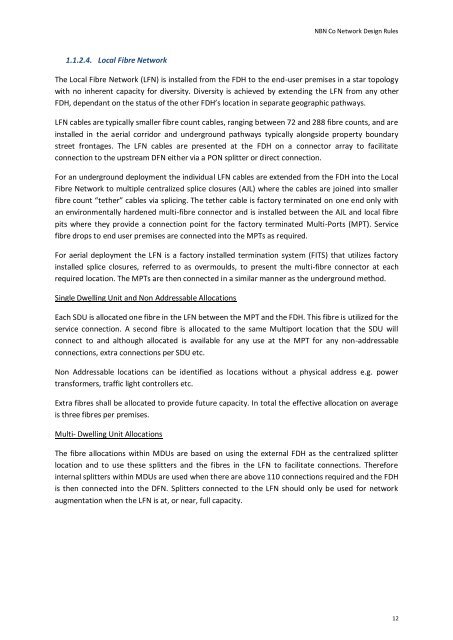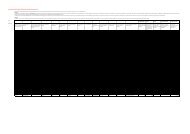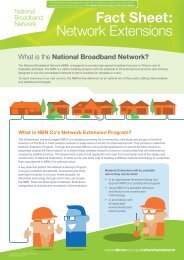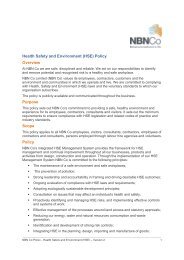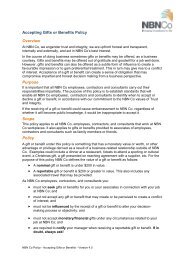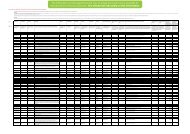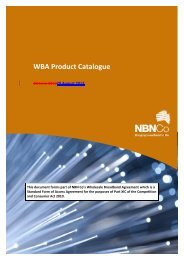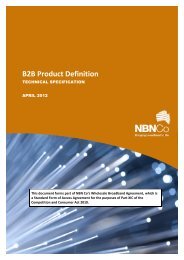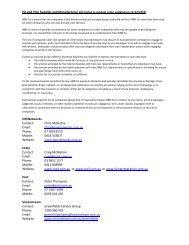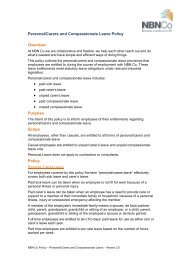NBN Co Network Design Rules
NBN Co Network Design Rules
NBN Co Network Design Rules
You also want an ePaper? Increase the reach of your titles
YUMPU automatically turns print PDFs into web optimized ePapers that Google loves.
<strong>NBN</strong> <strong>Co</strong> <strong>Network</strong> <strong>Design</strong> <strong>Rules</strong><br />
1.1.2.4. Local Fibre <strong>Network</strong><br />
The Local Fibre <strong>Network</strong> (LFN) is installed from the FDH to the end-user premises in a star topology<br />
with no inherent capacity for diversity. Diversity is achieved by extending the LFN from any other<br />
FDH, dependant on the status of the other FDH’s location in separate geographic pathways.<br />
LFN cables are typically smaller fibre count cables, ranging between 72 and 288 fibre counts, and are<br />
installed in the aerial corridor and underground pathways typically alongside property boundary<br />
street frontages. The LFN cables are presented at the FDH on a connector array to facilitate<br />
connection to the upstream DFN either via a PON splitter or direct connection.<br />
For an underground deployment the individual LFN cables are extended from the FDH into the Local<br />
Fibre <strong>Network</strong> to multiple centralized splice closures (AJL) where the cables are joined into smaller<br />
fibre count “tether” cables via splicing. The tether cable is factory terminated on one end only with<br />
an environmentally hardened multi-fibre connector and is installed between the AJL and local fibre<br />
pits where they provide a connection point for the factory terminated Multi-Ports (MPT). Service<br />
fibre drops to end user premises are connected into the MPTs as required.<br />
For aerial deployment the LFN is a factory installed termination system (FITS) that utilizes factory<br />
installed splice closures, referred to as overmoulds, to present the multi-fibre connector at each<br />
required location. The MPTs are then connected in a similar manner as the underground method.<br />
Single Dwelling Unit and Non Addressable Allocations<br />
Each SDU is allocated one fibre in the LFN between the MPT and the FDH. This fibre is utilized for the<br />
service connection. A second fibre is allocated to the same Multiport location that the SDU will<br />
connect to and although allocated is available for any use at the MPT for any non-addressable<br />
connections, extra connections per SDU etc.<br />
Non Addressable locations can be identified as locations without a physical address e.g. power<br />
transformers, traffic light controllers etc.<br />
Extra fibres shall be allocated to provide future capacity. In total the effective allocation on average<br />
is three fibres per premises.<br />
Multi- Dwelling Unit Allocations<br />
The fibre allocations within MDUs are based on using the external FDH as the centralized splitter<br />
location and to use these splitters and the fibres in the LFN to facilitate connections. Therefore<br />
internal splitters within MDUs are used when there are above 110 connections required and the FDH<br />
is then connected into the DFN. Splitters connected to the LFN should only be used for network<br />
augmentation when the LFN is at, or near, full capacity.<br />
12


